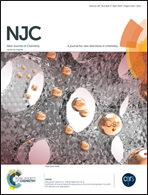Facile synthesis of single crystalline n-/p-type ZnO nanorods by lithium substitution and their photoluminescence, electrochemical and photocatalytic properties†
Abstract
Both n- and p-type single crystalline ZnO nanorods were successfully synthesized via a facile one step solvothermal method by lithium substitution. It was observed that substitution of Li is critical for the formation of n-type or p-type ZnO nanorods. The detailed formation mechanism indicates that the transition from n-type behavior to p-type behavior is due to the presence of defect states and lithium incorporation in the lattice. Using photoluminescence (PL) measurements, the role of defect states in generating the p-type or n-type nature of ZnO nanorods via Li substitution has been analyzed. Furthermore, the photocatalytic performances of the as-prepared ZnO nanorods have been investigated towards the degradation of rhodamine B and methyl orange, and the results demonstrate that the n-type ZnO nanorods behave as an excellent photocatalyst compared to the p-type ZnO nanorods owing to their higher charge carrier density.


 Please wait while we load your content...
Please wait while we load your content...